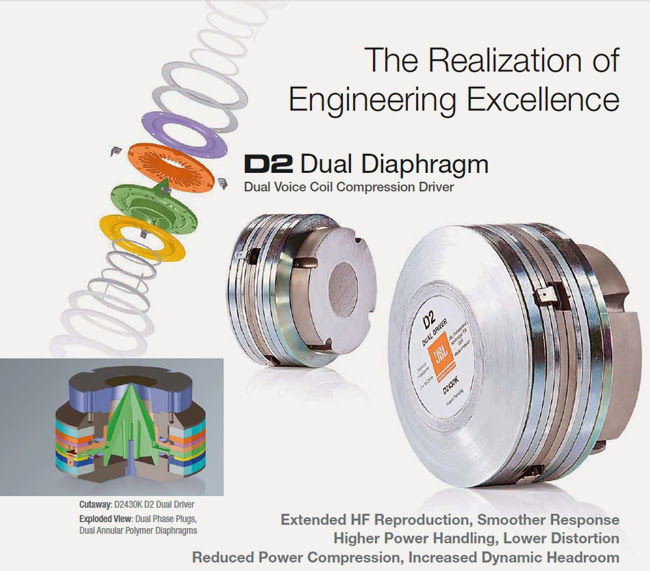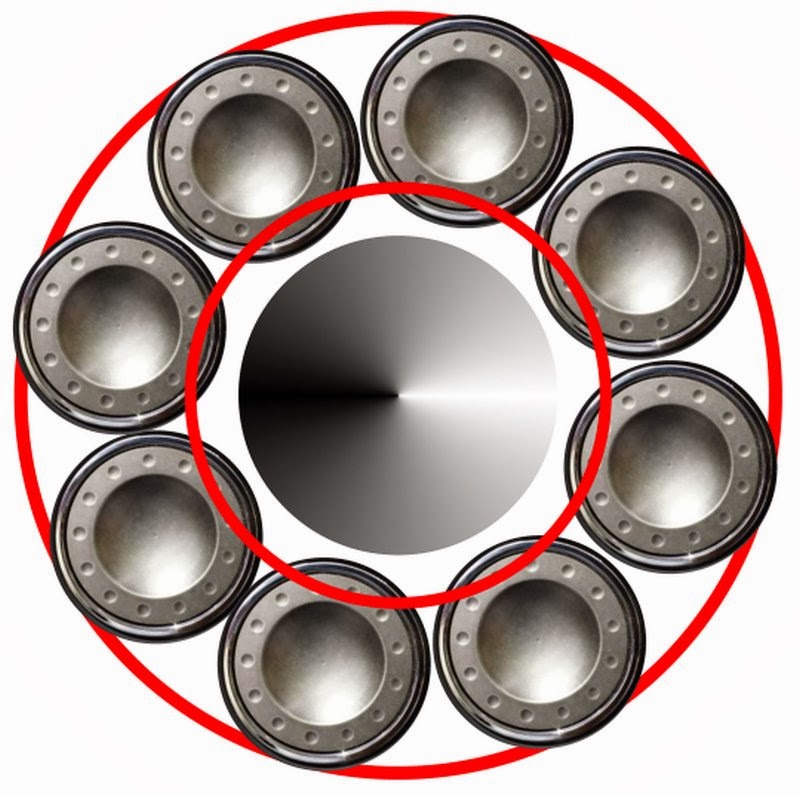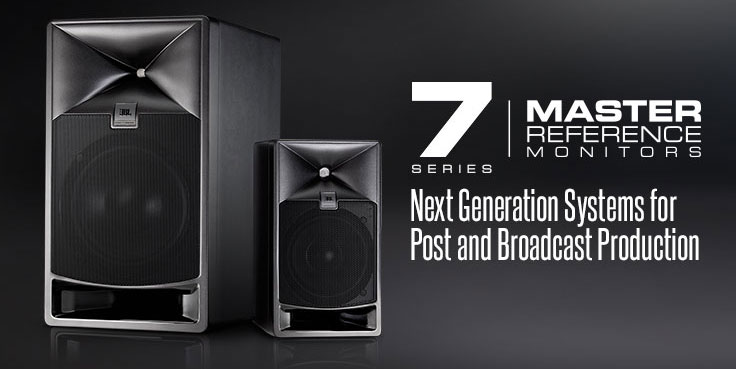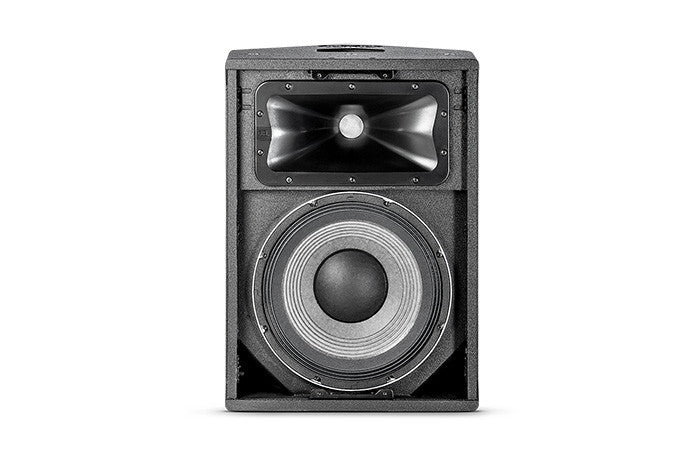Eight face to face with eight, or offset by 22.5 degrees?
will the phase plug origins be at the center of the driver,
or centered between drivers? I mean go ringways a bit,
then turn toward the central plug, the origin still being
at the center of the drivers... You could have up to 32
equally phased vents converging toward center in this
way...


You make a ring of eight drivers. Those eight drivers are facing a second ring of eight drivers. The phase plug is in the center of the ring. The entire setup is tested and proven, it's the exact same setup that JBL uses in the 2430K, the only difference is we're using a ring of dynamic drivers, instead of a single ring of mylar.
Sixteen drivers in an array will raise the sensitivity of the driver from 66 to 84dB. Horn loading generally adds another ten decibels or so.
You end up with a compression driver that has an efficiency of 94dB, and an excursion limit that's about an octave lower than the 'real' 2430K.
The main downside is maximum output. The JBL has more BL, due to a lighter diaphragm and more motor force. So the JBL will be capable of more maximum output, probably something in the neighborhood of 125dB per side.
But if someone could live with a max SPL in the neighborhood of 115dB, this would work well.
BTW, doing all of the calcs off of the top of my head. If someone wants to build this for real, they'll need a 3D printer. A hornresp model would be useful too. I tried modeling it in hornresp, but couldn't do it because the VAS is smaller than the smallest number that hornresp would allow. I think David McBean added another digit to the VAS field due to that.
Member
Joined 2003
I tried modeling it in hornresp, but couldn't do it because the VAS is smaller than the smallest number that hornresp would allow. I think David McBean added another digit to the VAS field due to that.
The minimum value of Vas that can be entered into Hornresp is 0.001 litres, or 1 cubic centimetre.
The Making of a Monitor: An Inside Look at How JBL Developed the M2 and Re-ignited Its Studio Line | Mixonline
{"Voishvillo, a Ph.D. who in a previous life designed studio monitors for the Russian Broadcasting Corporation, came up with the idea of foregoing the more traditional dome compression driver and developing a dual-annular diaphragm with dual 3.5-inch voice coils. The result was higher SPL, greater efficiency, less power required.
“We split into two annular diaphragms made out of special high polymers, thermoformed and very light,” Voishvillo explains. “Then we have two coils doing the job of one coil. That means there is half as much power delivered to each coil, so we have low thermal compression. It’s lighter, more flexible, with lower moving mass, matching phasing plugs and internal damping. And it has ultra-low distortion.”
The Bi-Radial horn that we have had for decades was a 90x60 horn, and not the best match for the low frequency device in the M2,” Sprinkle says. “This horn is 120 degrees horizontal and 110 degrees vertical. We knew that if we wanted a good directivity transition between the woofer and the high frequencies, we had to have that amount of pattern, so the waveguide was designed to have a pattern consistent with what the woofer was doing with no discontinuity at the crossover point, which is 800 Hz. “The second thing we did was use a blending geometry—there are no straight lines, you’ll notice—that has a generally decreasing radius,” he continues, “forming an infinite number of reflections, and the net effect is that it smears the reflections coming back down the horn and negates them.
“The third thing we did is bring these ‘knuckles,’ which is a name that sort of stuck, in from the side so that rather than having this 1.5-inch aperture that we had in the Bi-Radial design, we were able to get the upper pattern control frequency up near 10k, much like it would be with a 25mm dome. You combine that with a high-frequency device that has the internal damping characteristics this driver has, and it sounds like a silk-dome! That nice, sweet, effortless, open sound. In the process, that directivity characteristic in the mid-band went away. Alan was really a champion of doing the right thing with the architecture: driver placement, making the cabinet taller—that opened the door to the work that was done on the waveguide
“The second thing we did was use a blending geometry—there are no straight lines, you’ll notice—that has a generally decreasing radius,” he continues, “forming an infinite number of reflections, and the net effect is that it smears the reflections coming back down the horn and negates them. “The third thing we did is bring these ‘knuckles,’ which is a name that sort of stuck, in from the side so that rather than having this 1.5-inch aperture that we had in the Bi-Radial design, we were able to get the upper pattern control frequency up near 10k, much like it would be with a 25mm dome. You combine that with a high-frequency device that has the internal damping characteristics this driver has, and it sounds like a silk-dome! That nice, sweet, effortless, open sound. In the process, that directivity characteristic in the mid-band went away. Alan was really a champion of doing the right thing with the architecture: driver placement, making the cabinet taller—that opened the door to the work that was done on the waveguide.”
“The third thing we did is bring these ‘knuckles,’ which is a name that sort of stuck, in from the side so that rather than having this 1.5-inch aperture that we had in the Bi-Radial design, we were able to get the upper pattern control frequency up near 10k, much like it would be with a 25mm dome. You combine that with a high-frequency device that has the internal damping characteristics this driver has, and it sounds like a silk-dome! That nice, sweet, effortless, open sound. In the process, that directivity characteristic in the mid-band went away. Alan was really a champion of doing the right thing with the architecture: driver placement, making the cabinet taller—that opened the door to the work that was done on the waveguide."}"
Same link as above;
- See more at: The Making of a Monitor: An Inside Look at How JBL Developed the M2 and Re-ignited Its Studio Line | Mixonline
{"Voishvillo, a Ph.D. who in a previous life designed studio monitors for the Russian Broadcasting Corporation, came up with the idea of foregoing the more traditional dome compression driver and developing a dual-annular diaphragm with dual 3.5-inch voice coils. The result was higher SPL, greater efficiency, less power required.
“We split into two annular diaphragms made out of special high polymers, thermoformed and very light,” Voishvillo explains. “Then we have two coils doing the job of one coil. That means there is half as much power delivered to each coil, so we have low thermal compression. It’s lighter, more flexible, with lower moving mass, matching phasing plugs and internal damping. And it has ultra-low distortion.”
The Bi-Radial horn that we have had for decades was a 90x60 horn, and not the best match for the low frequency device in the M2,” Sprinkle says. “This horn is 120 degrees horizontal and 110 degrees vertical. We knew that if we wanted a good directivity transition between the woofer and the high frequencies, we had to have that amount of pattern, so the waveguide was designed to have a pattern consistent with what the woofer was doing with no discontinuity at the crossover point, which is 800 Hz. “The second thing we did was use a blending geometry—there are no straight lines, you’ll notice—that has a generally decreasing radius,” he continues, “forming an infinite number of reflections, and the net effect is that it smears the reflections coming back down the horn and negates them.
“The third thing we did is bring these ‘knuckles,’ which is a name that sort of stuck, in from the side so that rather than having this 1.5-inch aperture that we had in the Bi-Radial design, we were able to get the upper pattern control frequency up near 10k, much like it would be with a 25mm dome. You combine that with a high-frequency device that has the internal damping characteristics this driver has, and it sounds like a silk-dome! That nice, sweet, effortless, open sound. In the process, that directivity characteristic in the mid-band went away. Alan was really a champion of doing the right thing with the architecture: driver placement, making the cabinet taller—that opened the door to the work that was done on the waveguide
“The second thing we did was use a blending geometry—there are no straight lines, you’ll notice—that has a generally decreasing radius,” he continues, “forming an infinite number of reflections, and the net effect is that it smears the reflections coming back down the horn and negates them. “The third thing we did is bring these ‘knuckles,’ which is a name that sort of stuck, in from the side so that rather than having this 1.5-inch aperture that we had in the Bi-Radial design, we were able to get the upper pattern control frequency up near 10k, much like it would be with a 25mm dome. You combine that with a high-frequency device that has the internal damping characteristics this driver has, and it sounds like a silk-dome! That nice, sweet, effortless, open sound. In the process, that directivity characteristic in the mid-band went away. Alan was really a champion of doing the right thing with the architecture: driver placement, making the cabinet taller—that opened the door to the work that was done on the waveguide.”
“The third thing we did is bring these ‘knuckles,’ which is a name that sort of stuck, in from the side so that rather than having this 1.5-inch aperture that we had in the Bi-Radial design, we were able to get the upper pattern control frequency up near 10k, much like it would be with a 25mm dome. You combine that with a high-frequency device that has the internal damping characteristics this driver has, and it sounds like a silk-dome! That nice, sweet, effortless, open sound. In the process, that directivity characteristic in the mid-band went away. Alan was really a champion of doing the right thing with the architecture: driver placement, making the cabinet taller—that opened the door to the work that was done on the waveguide."}"
Same link as above;
- See more at: The Making of a Monitor: An Inside Look at How JBL Developed the M2 and Re-ignited Its Studio Line | Mixonline
Last edited:
Why don't you just buy the D2430K and call it a day? They aren't cheap but you know they will perform.
I thought someone on the forum did that, and it turned out to be a lemon?
If the D2430Ks that are on eBay are B-Stock or defective, then I'd take a pass on them.
AFAIK, there is no way to buy the D2430K new.
And I *did* buy the closest thing to a D2430K that you *can* buy, the JBL 2408H-1. (It's basically half of a D2430K; same phase plug but a single diaphragm.)
Im sure some here or on the prosound forums can get their hands on them, seeing as they are used in JBL's vtx line array's with 3 2415k's in the VT20 and 3 2430k's in the VT25 plus they are used in the F12 fill monitor, they are bound to need replacements on the road from time to time. They can't be any more expensive then the Radian Be. JBL is built on high margins, Im betting those D2's can be had pretty reasonable to a JBL pro dealer. VTX Series
Im sure some here or on the prosound forums can get their hands on them, seeing as they are used in JBL's vtx line array's with 3 2415k's in the VT20 and 3 2430k's in the VT25 plus they are used in the F12 fill monitor, they are bound to need replacements on the road from time to time. They can't be any more expensive then the Radian Be. JBL pro dealers are built on high margins, Im betting those D2's can be had pretty reasonable to a JBL pro dealer. VTX Series
edit:
http://www.audioheritage.org/vbulletin/showthread.php?35490-D2415k
Last edited:
I thought someone on the forum did that, and it turned out to be a lemon?
If the D2430Ks that are on eBay are B-Stock or defective, then I'd take a pass on them.
AFAIK, there is no way to buy the D2430K new.
And I *did* buy the closest thing to a D2430K that you *can* buy, the JBL 2408H-1. (It's basically half of a D2430K; same phase plug but a single diaphragm.)
2408H vs 2408H-1 differences?
And this?
JBL 2408H-2
I've made some M2 "style" waveguides. Here's some pics and measurements here:
Car Audio | DiyMobileAudio.com | Car Stereo Forum - View Single Post - 250 - A Sweet Front Stage On The Cheap.
Car Audio | DiyMobileAudio.com | Car Stereo Forum - View Single Post - 250 - A Sweet Front Stage On The Cheap.
The technology from the M2 is starting to trickle down into the rest of the line.

First off, we have the LSR708i. To me, it looks like a 1/4 scale version of the M2. As I noted earlier in the thread, the JBL 2408H-1 has a lot in common with the D2 2430K. The LSR708i doesn't use the 2408H-1, it uses a new compression driver called the 2409H. I'm too lazy to dig through the patents, but I'm willing to bet the 2409H is an evolution of the 2408H-1.
It costs $1500 a pair IIRC.

The JBL VTX F12 is an interesting item. It features the exact same compression driver as the M2, but paired with the waveguide that Zilch selected for his Econowave design. The VTX F12 is under $2000 each.
http://www.jblpro.com/ProductAttachments/JBL_VTX_F12.v9.pdf
Check out the specs, particularly the polars. The F12 would be a compelling option for someone that likes to listen LOUD.
So basically there's a few options here:
1) if you want the best and you can afford it, the M2 is really nice. There's a used pair from Paramount Pictures on sale for $15,000 on eBay right now.
2) if you can live with the ugly cabinet, the VTX F12 has some really nice polars and it's price won't break the bank
3) The LSR708i loses directivity control at 2khz, but if you can live with that, it's a fraction of the price and the cabinet looks sharp.

First off, we have the LSR708i. To me, it looks like a 1/4 scale version of the M2. As I noted earlier in the thread, the JBL 2408H-1 has a lot in common with the D2 2430K. The LSR708i doesn't use the 2408H-1, it uses a new compression driver called the 2409H. I'm too lazy to dig through the patents, but I'm willing to bet the 2409H is an evolution of the 2408H-1.
It costs $1500 a pair IIRC.

The JBL VTX F12 is an interesting item. It features the exact same compression driver as the M2, but paired with the waveguide that Zilch selected for his Econowave design. The VTX F12 is under $2000 each.
http://www.jblpro.com/ProductAttachments/JBL_VTX_F12.v9.pdf
Check out the specs, particularly the polars. The F12 would be a compelling option for someone that likes to listen LOUD.
So basically there's a few options here:
1) if you want the best and you can afford it, the M2 is really nice. There's a used pair from Paramount Pictures on sale for $15,000 on eBay right now.
2) if you can live with the ugly cabinet, the VTX F12 has some really nice polars and it's price won't break the bank
3) The LSR708i loses directivity control at 2khz, but if you can live with that, it's a fraction of the price and the cabinet looks sharp.
"but paired with the waveguide that Zilch selected for his Econowave design. "
I believe you meant to say: the 1.5" throat version of the econowave horn.
JBL*90 x 50 1.5" throat horn
JBL 5006815
I believe you meant to say: the 1.5" throat version of the econowave horn.
JBL*90 x 50 1.5" throat horn
JBL 5006815
Last edited:
Looks like many of the parts for the M2 are now available for purchase seperately. If someone was brave you could attempt to clone one for real.
1) You can get the 2216ND woofer for $560
2) You can get the 5025594 waveguide for $350
3) The compression driver is tricky to find. It's a JBL D2430K. As it's also used in their pro gear, it pops up occasionally on eBay, sourced out of new or used line arrays. The cost is usually about $500
If you *really* did your homework you could probably put together a pair of these for around $4000, depending on which amps you used
The 'real deal' are $12,000 a pair without amplification or DSP
1) You can get the 2216ND woofer for $560
2) You can get the 5025594 waveguide for $350
3) The compression driver is tricky to find. It's a JBL D2430K. As it's also used in their pro gear, it pops up occasionally on eBay, sourced out of new or used line arrays. The cost is usually about $500
If you *really* did your homework you could probably put together a pair of these for around $4000, depending on which amps you used
The 'real deal' are $12,000 a pair without amplification or DSP
IIRC When Dr Toole was 'fronting' for the M2 and it's virtually flat Fr /Db curve He said it was it's Electronic equalisation circuits that were the Backbone of the M2's.
Albeit their mech parts seem as V well machined bits... without the EQ circuits, One would likely be peeing in total darkness.
Perhaps a bit more involved than emulating pieces of Hardware.
He also mentioned that in his testings a competitors' 1800$ speaker pair came/comes embarrassingly close to the M2's performances.
No.. he didn't name names.. too bad.
Albeit their mech parts seem as V well machined bits... without the EQ circuits, One would likely be peeing in total darkness.
Perhaps a bit more involved than emulating pieces of Hardware.
He also mentioned that in his testings a competitors' 1800$ speaker pair came/comes embarrassingly close to the M2's performances.
No.. he didn't name names.. too bad.
Last edited:
He said it was it's Electronic equalisation circuits that were the Backbone of the M2's.
.... and that is the part for which the customer has to pay much more than the speaker as such.
The speaker itself is quite reasonably priced for the professional tool it is, given that the main ingredients cost slightly more than USD 2000.-/pair.
Regards
Charles
Last edited:
- Home
- Loudspeakers
- Multi-Way
- JBL M2 for The Poors
